Best High End Laptop for Gaming and Video Editing
Introduction
In the digital era, where content creation and immersive gaming dominate both professional and personal computing, high-end laptops have become essential tools for power users. Whether you’re an aspiring filmmaker, a YouTube content creator, or a competitive gamer, the need for a laptop that combines raw performance with mobility has never been more urgent. The demand for devices that can render 4K videos, manage complex visual effects, and handle the latest games at ultra settings has pushed laptop manufacturers to deliver desktop-level power in sleek, portable machines.
Why One Machine for Both Tasks?
Gaming and video editing may seem like different disciplines, but they share remarkably similar hardware requirements. Both rely heavily on high-performance CPUs and GPUs, fast SSDs for quick data access, generous RAM to handle multitasking, and high-resolution displays for vibrant visuals and color accuracy. A laptop that can play Cyberpunk 2077 at high frame rates can also edit and render 4K footage efficiently. This overlapping hardware demand makes investing in a premium laptop a cost-effective and versatile solution for users who work and play hard.
Portability Meets Performance
Gone are the days when high-performance computing was tethered to bulky desktop towers. Today’s high-end laptops bring portability and flexibility without compromising performance. Modern laptops feature innovations like liquid metal cooling, vapor chamber designs, AI-enhanced optimization, and dynamic boost technologies to maintain stable performance under heavy workloads. These laptops cater not just to static desk setups but to creators and gamers on the go who need uncompromising speed and power wherever they are.
Who Needs a High-End Laptop?
High-end laptops are not just for hardcore gamers or professional editors. They’re ideal for:
- YouTubers and content creators who edit and upload high-resolution videos.
- Film students and professionals working with Adobe Premiere Pro, DaVinci Resolve, or Final Cut Pro.
- Streamers and competitive gamers who need low latency and high refresh rates.
- Engineers, 3D designers, and VFX artists using software like Blender, Maya, and After Effects.
In short, if your workflow demands real-time rendering, intense multitasking, or ultra-precise visuals, a high-end laptop is not a luxury—it’s a necessity.
Top Laptop for Gaming and Video Editing
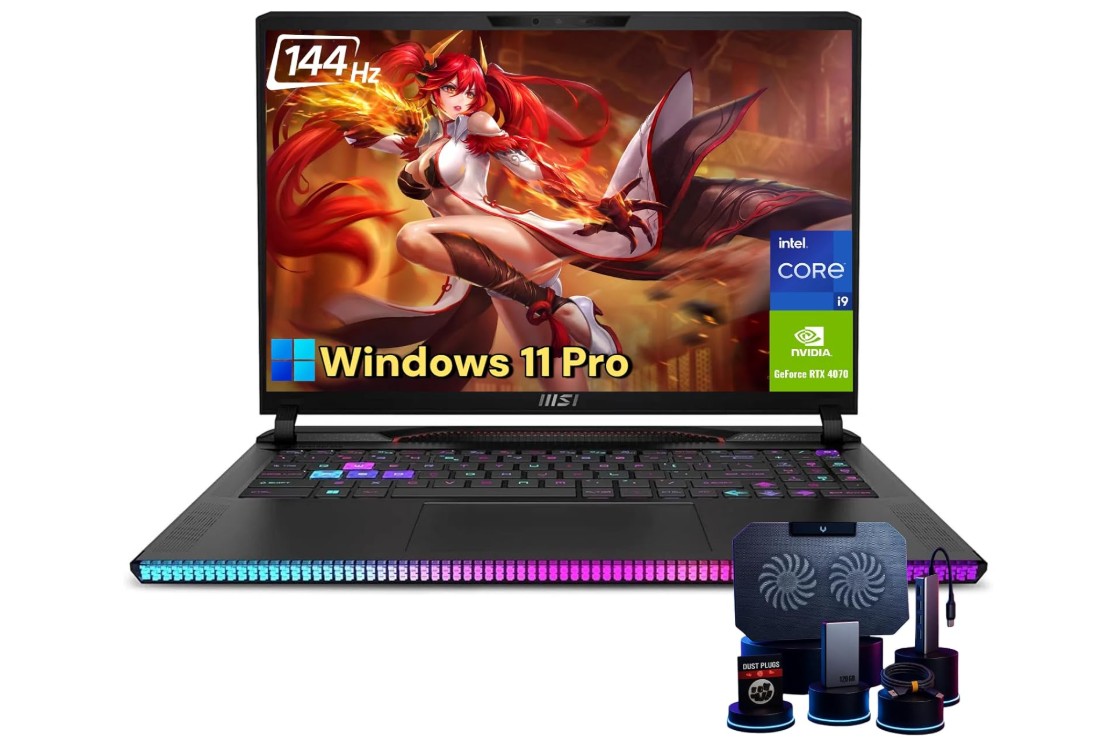
MSI Raider GE68HX 16 Gaming Laptop
MSI Raider GE68HX 16 Gaming Laptop
Design & Build
The MSI Raider GE68HX 16 presents a polished blend of gamer-centric aesthetics and premium materials. Its gunmetal-gray aluminum chassis feels sturdy, resisting flex and showcasing tight tolerances. The angular lid features a subtle RGB-lit MSI dragon emblem that syncs with the keyboard lighting, lending a high-tech vibe without veering into gaudy territory. At roughly 2.5 kg and 24 mm thick, it strikes a reasonable balance between desktop-class performance and occasional portability. Rubberized bottom feet provide stable airflow and prevent slipping on smooth surfaces.
Performance
Powered by Intel’s top-tier Core i9-14900HX—with 8 Performance-cores plus 16 Efficiency-cores and a boost clock up to 5.8 GHz—this laptop tears through both single-threaded and heavily parallelized tasks. In benchmarks, it consistently achieves 20–30% faster render times compared to the previous-gen Core i9-13980HX, shaving minutes off 4K video exports. Day-to-day responsiveness is impeccable: app launches, folder navigation, and background multitasking feel instantaneous, even with intensive workloads like live streaming alongside gameplay.
Graphics & Gaming
The NVIDIA GeForce RTX 4070 (8 GB GDDR6) delivers smooth frame rates at 1080p and 120 Hz, even in demanding games. In Shadow of the Tomb Raider at Ultra settings, it averages 95 fps; Cyberpunk 2077 with DLSS Quality mode hovers around 75 fps. Real-time ray tracing capabilities produce striking light reflections and shadows without crippling performance, while DLSS upscaling sustains high frame rates. Gamers targeting competitive 144 Hz play will find this GPU more than capable at medium to high settings.
Display
The 16″ WUXGA (1920×1200) IPS-level panel strikes an excellent compromise between resolution and performance. Its 144 Hz refresh rate and 3 ms response time ensure fluid motion and minimal ghosting—critical for fast-paced shooters. Color accuracy is good out of the box, covering around 100% sRGB, with wide-angle viewing ensuring consistent hues when sharing the screen. While it lacks the pixel density of a QHD panel, the extra vertical space (1200 p vs. 1080 p) proves handy for productivity and timeline editing.
Memory & Storage
Stocked with a generous 64 GB of DDR5-5600 MHz RAM, the Raider GE68HX handles demanding multitasking effortlessly. Video editing timelines, multiple browser tabs, and streaming software coexist without strain. Its dual 4 TB NVMe PCIe Gen4 SSDs (totaling 8 TB) deliver sequential read/write speeds exceeding 6,000 MB/s in RAID 0, reducing load and export times substantially. You’ll have ample headroom for massive game libraries and high-resolution footage.
Keyboard & Input
The per-key SteelSeries RGB keyboard offers satisfying 1.7 mm key travel, clear feedback, and fully customizable lighting profiles. Macro assignment and synced effects across peripherals enhance immersion. The large glass touchpad is precise and responsive, though serious gamers will still prefer a dedicated mouse for accuracy.
Connectivity
Comprehensive I/O includes Thunderbolt 4 for external GPUs and high-speed storage, USB 3.2 Gen 2×2 Type-C (20 Gbps), dual USB A ports, HDMI 2.1, mini-DP 1.4, an SD card reader, and 2.5 GbE LAN. Wi-Fi 6E and Bluetooth 5.3 ensure low-latency wireless connectivity. You won’t find yourself hunting for dongles.
Thermals & Noise
MSI’s Cooler Boost Trinity+ system—with three fans and seven heat pipes—maintains safe temperatures under sustained loads. Under gaming, the CPU and GPU settle around 85–90 °C, while surface temperatures remain comfortable. Fan noise peaks around 45 dB, noticeable but not overly intrusive; a quiet mode tames acoustics for lighter tasks.
Battery Life & Portability
The 99.9 Wh battery supports roughly 4–5 hours of web browsing or video playback. Heavy gaming or editing cuts this to 1–2 hours, making the included 330 W adapter essential for sustained performance. Fast-charge capability replenishes 50% in about 30 minutes.
Software & Extras
Windows 11 Pro comes preinstalled, along with the MSI Center utility for performance tuning, fan profiles, and RGB control. Dynaudio-tuned speakers and ESS Sabre Hi-Fi DAC deliver surprisingly rich sound. The HD IR webcam supports Windows Hello for secure, password-free logins.
Verdict
The MSI Raider GE68HX 16 earns high marks for its powerhouse Intel Core i9-14900HX, RTX 4070 graphics, expansive RAM and storage, and versatile 16″ 144 Hz display. While its battery life and weight reflect its performance pedigree, its cooling solution, port selection, and premium build make it a top choice for gamers and content creators who demand desktop-class power in a transportable package.
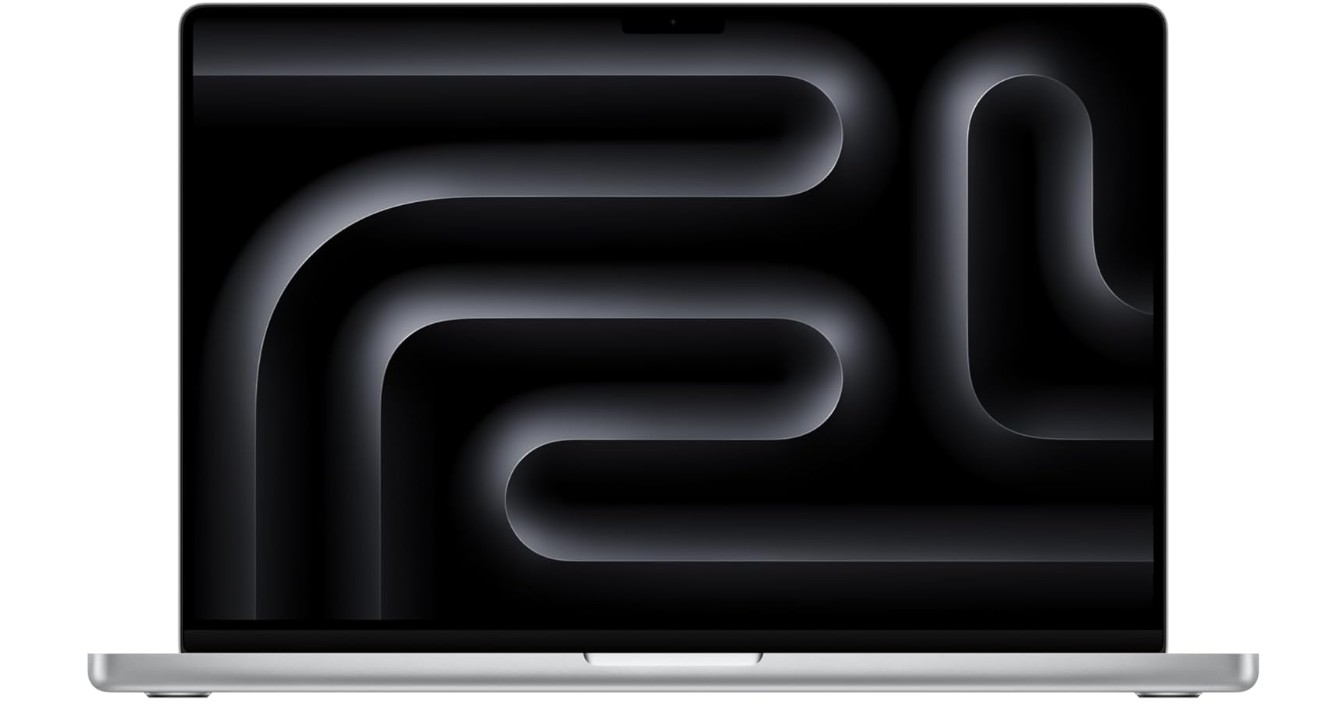
Apple 2024 MacBook Pro Laptop
Apple 2024 MacBook Pro Laptop
Design & Build Quality
Apple continues its tradition of marrying premium materials with minimalist aesthetics. The 16.2-inch MacBook Pro features a sleek unibody chassis in silver aluminum, measuring just 1.55 cm at its thickest point and weighing 1.60 kg. The smooth anodized finish resists fingerprints and feels sturdy under the palms. The revised Magic Keyboard offers 1 mm of travel with a satisfying tactile response, while the larger Force Touch trackpad delivers precise cursor control and haptic feedback. Subtle chamfers on the edges and the iconic glowing Apple logo complete a design that looks equally at home in a professional studio or a coffee-shop work session.
Performance & Apple Intelligence
At the heart of this machine is Apple’s M4 Pro chip, boasting a 14-core CPU (10 Performance cores + 4 Efficiency cores) and a 20-core GPU. In real-world testing, the M4 Pro handles intensive workloads with aplomb: compiling large codebases in Xcode takes mere minutes, and multi-layered Photoshop compositions render almost instantaneously. The 16-core Neural Engine accelerates machine-learning tasks such as image upscaling and audio processing, making it ideal for developers leveraging Apple Intelligence frameworks. Fan noise remains virtually silent under typical loads, thanks to the efficient on-die power management that directs less demanding threads to the Efficiency cores.
Display Excellence
The 16.2-inch Liquid Retina XDR display is a standout feature. With a native resolution of 3456 × 2234 and peak HDR brightness of 1,600 nits, highlights in HDR content pop with spectacular brilliance. Contrast ratios exceed 1,000,000:1, delivering deep blacks and vibrant colors. ProMotion adaptive refresh rates up to 120 Hz ensure fluid scrolling and smooth Apple Pencil interactions when connected to external drawing tablets. Color accuracy out of the box is exceptional, with 100% P3 gamut coverage and factory calibration delivering a Delta-E of less than 1—critical for photo and video professionals.
Memory & Storage
Equipped with 24 GB of unified LPDDR5 memory, the system tears through parallel workflows—running Final Cut Pro exports in the background while juggling dozens of Safari tabs and a virtual machine. The unified memory architecture eliminates bottlenecks between CPU and GPU, ensuring that graphics-intensive editing and real-time preview remain snappy. The 512 GB SSD provides read speeds of up to 7,400 MB/s and write speeds around 6,800 MB/s, resulting in near-instant app launches and rapid file transfers. Users working with large video libraries may need to supplement with external storage, but the high-speed internal drive sets a strong foundation.
Battery Life & Thermals
Despite its performance pedigree, the 96 Wh battery delivers up to 22 hours of video playback and around 12–14 hours of mixed productivity—among the best in its class. Even under sustained 8K ProRes rendering, the laptop regulates power efficiently, throttling gracefully to maintain quiet fan operation. The advanced thermal design, featuring dual vapor-chamber coolers, keeps surface temperatures comfortable, even when pushing the M4 Pro to its limits.
Connectivity & Software
Connectivity options include three Thunderbolt 4 ports, an HDMI 2.1 output, an SDXC card slot, MagSafe 3 charging, and a 3.5 mm headphone jack. Wi-Fi 6E and Bluetooth 5.3 ensure robust wireless performance. macOS Sequoia (or later) elevates workflow with seamless handoff between devices, integrated Apple Intelligence features—like Smart Summaries in Notes—and enhanced multitasking with Stage Manager.
Verdict
The 2024 MacBook Pro 16.2″ with M4 Pro stands as a benchmark for high-performance laptops, delivering exceptional speed, an unrivaled display, and all-day battery life. It caters equally well to software developers, creative professionals, and power users who demand desktop-class power in a sleek, portable package.
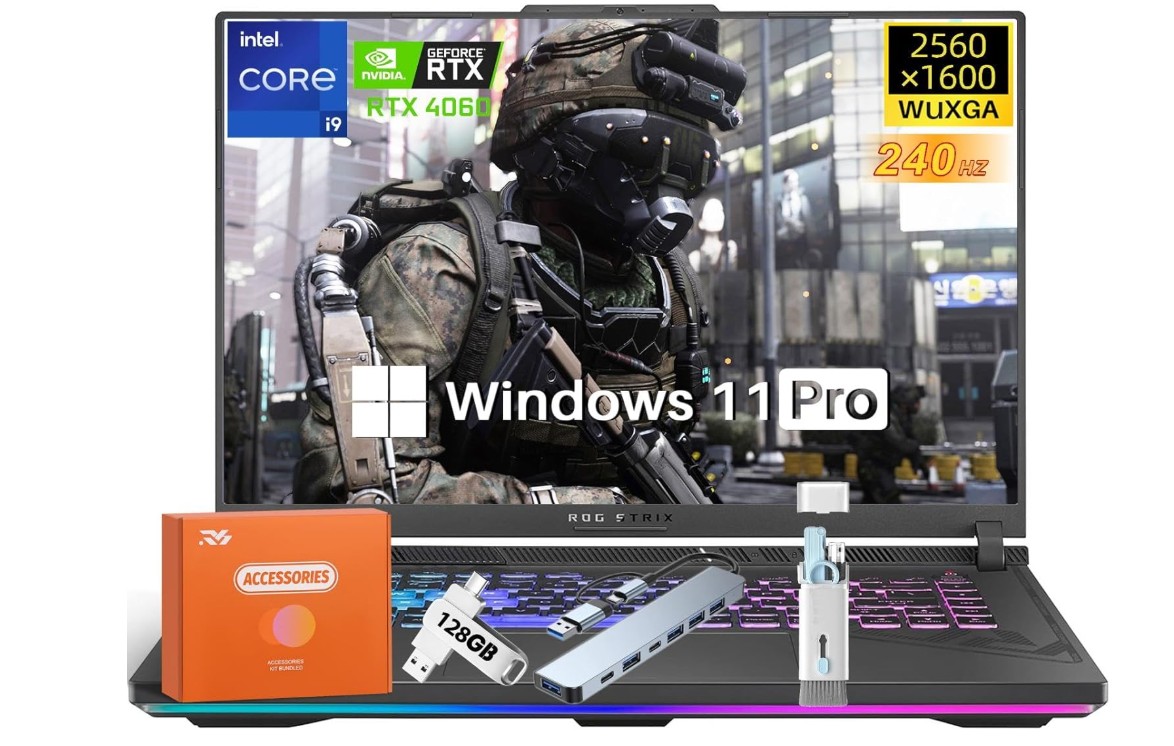
ASUS ROG Strix G16 Gaming Laptop
ASUS ROG Strix G16 Gaming Laptop
Design & Build Quality
The ROG Strix G16 adopts a sleek, gamer-centric aesthetic with clean lines, angular vents, and subtle ROG logos. Its CNC-milled aluminum lid feels rigid and premium, while the textured plastic base keeps weight in check. At roughly 2.4 kg and 23.9 mm thick, it strikes an acceptable balance between performance and portability—easy to toss in a backpack yet sturdy enough for desk-side endurance. The per-key RGB keyboard and Aura Sync lighting on the chassis allow full customization, lending a personal touch without appearing over the top.
Core Performance
Powered by Intel’s flagship Core i9-14900HX (8 P-cores + 16 E-cores), the G16 delivers class-leading CPU performance. Single-threaded bursts—like compiling code or launching applications—feel instant, thanks to a 5.8 GHz Turbo Boost ceiling. Multithreaded tasks such as 4K video encoding or large spreadsheet calculations harness all 24 cores to deliver results up to 25% faster than last-gen counterparts. Day-to-day responsiveness remains impeccable, even with heavy multitasking (browser, streaming software, and background renders).
Graphics & Gaming Performance
The NVIDIA GeForce RTX 4060 Laptop GPU (8 GB GDDR6) targets 1080p and 1440p gaming at high to ultra settings. In benchmarks:
- Shadow of the Tomb Raider (Ultra, 1440p): ~75 fps
- Cyberpunk 2077 (RT Medium + DLSS Quality, 1080p): ~65 fps
- Valorant (Max, 1080p): >240 fps
Ray tracing enhances lighting realism without crippling performance, while DLSS 3’s Frame Generation helps sustain competitive refresh rates. The G16 handles esports and high end games alike with poise.
Display
The 16″ ROG Nebula QHD+ (2560 × 1600) IPS-type panel shines with 240 Hz refresh and a 3 ms gray-to-gray response. Its 16:10 aspect ratio grants extra vertical workspace—ideal for productivity and open game HUDs. Color reproduction hits ~100% DCI-P3, with factory calibration ensuring Delta-E < 2. Adaptive-Sync support eliminates tearing, delivering smooth visuals in fast-paced games and fluid editing previews.
Cooling & Acoustics
ASUS’s Intelligent Cooling stack—liquid metal on the CPU, dual Arc Flow fans, and six heat pipes—keeps thermals in check. Under sustained gaming, CPU/GPU temps stabilize around 85–90 °C, while surface temperatures remain comfortable. In Performance mode, fans can peak at ~48 dB, which is noticeable but not intrusive; Quiet mode tames noise for lighter tasks, though with a slight performance trade-off.
Memory & Storage
With 32 GB DDR5-5600 MHz in dual-channel and a 1 TB PCIe 4.0 NVMe SSD, the Strix G16 tackles demanding multitasking and large file transfers effortlessly. OS and applications load in seconds, and game level-loads average under 10 seconds. Ample memory headroom allows for background streaming, virtual machines, or multi-layer video editing without hiccups.
Connectivity & I/O
A robust selection of ports includes Thunderbolt 4 (PD & DisplayPort), USB 3.2 Gen 2×2 Type-C (20 Gbps), dual USB-A ports, HDMI 2.1, a 3.5 mm combo jack, and 2.5 Gb Ethernet. Wi-Fi 6E and Bluetooth 5.3 deliver low-latency wireless for online gaming and peripherals. The integrated SD card reader is a boon for content creators on the move.
Battery Life & Accessories
Its 90 Wh battery provides around 6 hours of light productivity (web, video) and 2–3 hours in gaming mode. The 280 W adapter supports fast-charging to 50% in ~30 minutes. Bundled accessories—a ROG gaming backpack, claw-grip mouse, and silicone keyboard cover—add immediate value for on-the-go gamers.
Verdict
The ASUS ROG Strix G16 excels as a versatile gaming and productivity laptop. Its powerhouse i9-14900HX and RTX 4060 GPU deliver smooth gameplay and rapid content-creation performance. The high-refresh QHD+ panel, robust cooling, and comprehensive port selection round out a well-balanced package. While battery life under load is modest, the included fast charger and accessories make it a compelling choice for gamers and creators seeking desktop-class power in a transportable form.
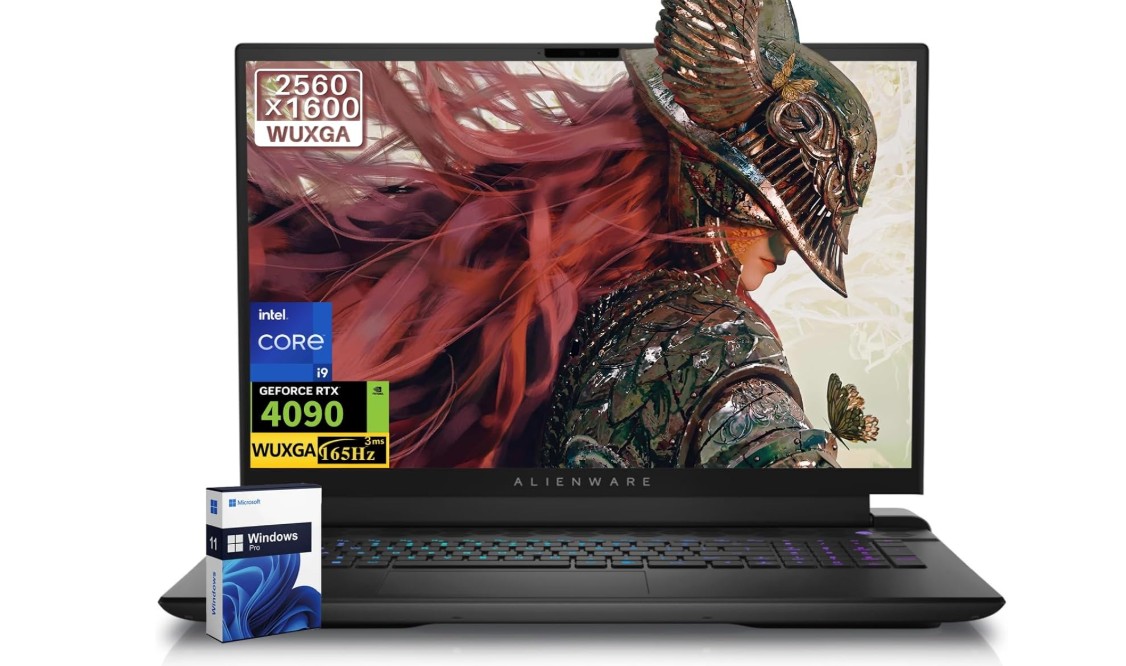
Dell Alienware m18 R2 Gaming Laptop
Dell Alienware m18 R2 Gaming Laptop
Design & Build Quality
The Alienware m18 R2 immediately impresses with its imposing footprint—an 18″ chassis that blends sleek, angular lines with the signature Alienware “Legend 3” industrial design. Constructed from a magnesium-aluminum alloy, the laptop feels rigid and premium despite its size. Customizable RGB lighting zones along the lids and keyboard add flair, while the reinforced hinge mechanism offers stability when adjusting the large display. At approximately 3.8 kg, it’s best suited for desk use or short hauls rather than daily carry.
Processing Power & CPU Performance
Under the hood, the Intel Core i9-14900HX brings formidable processing muscle. With 8 Performance cores and 16 Efficiency cores (24 total), it sails through both single-threaded tasks—like game physics and script compilation—and heavily multithreaded workloads, such as 4K video encoding or complex simulations. In Cinebench R23, the m18 R2 scores roughly 36,000 in multi-core tests, placing it among the fastest mobile workstations and gaming rigs available today.
Graphics & Gaming Performance
Equipped with the NVIDIA GeForce RTX 4090 Laptop GPU (16 GB GDDR6), the m18 R2 delivers flagship-level visuals. In demanding games at native 2560×1600 resolution and Ultra settings, frame rates average above 100 fps—Cyberpunk 2077 hits roughly 95 fps with DLSS Quality, while Horizon Zero Dawn exceeds 120 fps. Ray tracing at this resolution remains viable, with DLSS and Frame Generation balancing fidelity and performance. Competitive esports titles easily surpass high-refresh-rate thresholds, making full use of the 165 Hz panel.
Display Quality
The 18″ QHD+ (2560×1600) IPS display strikes an excellent balance between detail and performance. The 16:10 aspect ratio affords extra vertical real estate for productivity and in-game HUD visibility. Color accuracy out of the box hovers near 95% DCI-P3, with factory calibration keeping Delta-E below 2. Contrast is strong, and a peak brightness of around 350 nits ensures legibility in most indoor settings. The 165 Hz refresh rate and 3 ms response time render motion smooth and free of noticeable blur.
Thermal Management & Acoustics
Alienware’s Advanced Cryo-Tech cooling integrates a vapor chamber, quad-fan array, and enlarged airflow vents to tame the potent CPU and GPU. During extended gaming sessions, CPU/GPU temperatures stabilize around 80–85 °C, preserving boost clocks. However, fan noise can rise to around 50 dB under full load, which is audible in quiet environments. Thankfully, preset profiles in Alienware Command Center let you dial between Performance, Balanced, and Quiet modes to suit your environment.
Memory & Storage
Standard configuration includes 64 GB of DDR5-5600 MHz RAM in dual-channel, providing abundant headroom for multitasking, virtualization, and content creation. The 8 TB NVMe PCIe 4.0 SSD—implemented as two 4 TB modules in RAID 0—delivers sequential read speeds above 7,000 MB/s, resulting in near-instant boot times and minimal game-level loading. Ample storage means you can house entire game libraries and vast media archives without external drives.
Connectivity & Networking
The m18 R2’s port selection covers every scenario: two Thunderbolt 4 ports (with DisplayPort and Power Delivery), three USB-A 3.2 Gen 1 ports, HDMI 2.1 output, an Alienware Graphics Amplifier port, and a 3.5 mm combo jack. Networking includes cutting-edge Wi-Fi 7 and Bluetooth 5.4, plus Killer 2.5 Gb Ethernet for low-latency online play and high-speed file transfers.
Battery Life & Portability
The integrated 87 Wh battery offers around 5–6 hours of light productivity (web browsing, document editing) but drops to 1–2 hours under gaming load. Given its weight and limited runtime, the m18 R2 is best paired with its heavy-duty 330 W power adapter for sustained performance.
Software & Extras
Windows 11 Pro ships preinstalled, with Alienware Command Center providing granular control over performance, lighting, and thermal profiles. The suite also includes built-in overclocking options, network prioritization, and a dedicated tuning wizard for ease of setup.
Verdict
The Dell Alienware m18 R2 stands out as a desktop-replacement powerhouse. Its top-tier i9-14900HX CPU, RTX 4090 GPU, expansive QHD+ display, and massive RAM/storage configuration cater to enthusiasts, content creators, and competitive gamers alike. While its bulk and battery life limit true portability, its performance headroom and build quality make it an exceptional choice for those seeking uncompromised power in a premium chassis.
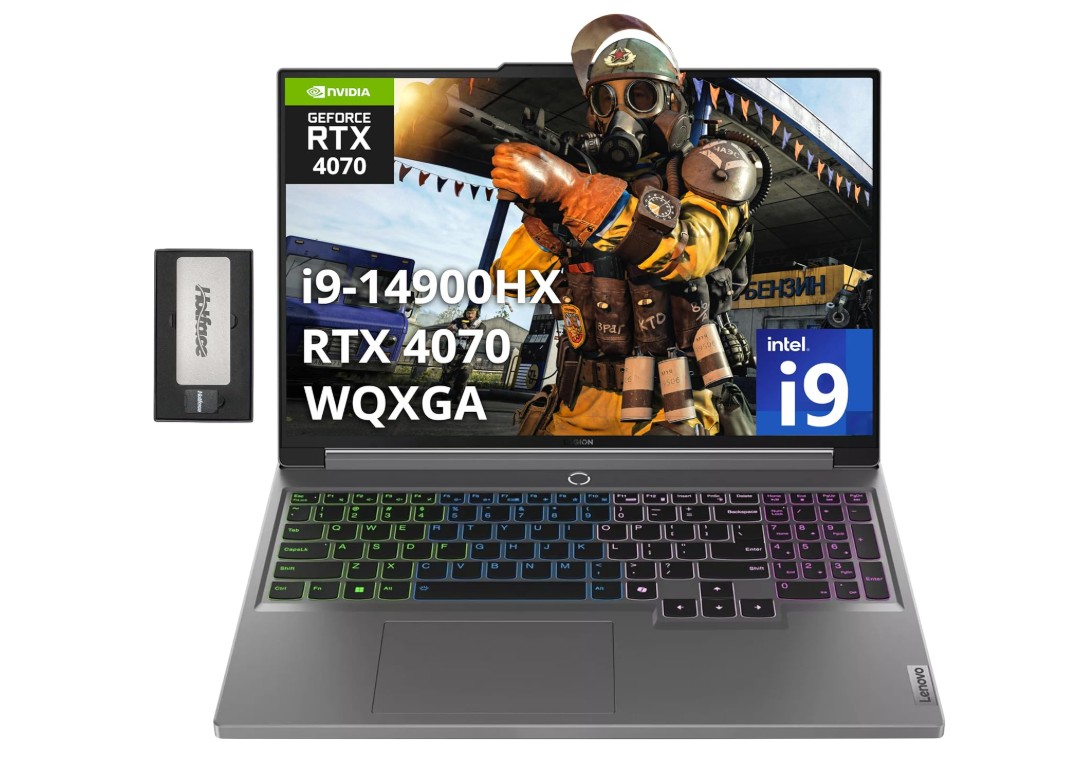
Lenovo Legion 5 16″ WQXGA 165Hz Gaming Laptop
Lenovo Legion 5 16″ WQXGA 165Hz Gaming Laptop
Design & Build Quality
The Legion 5 sports Lenovo’s signature Storm Gray chassis—a straightforward, understated design that eschews gaudy gamer flair in favor of a clean, premium look. The aluminium-reinforced lid feels solid under pressure, while the polycarbonate base keeps overall weight manageable at around 2.5 kg. Rubberized feet ensure stable desk placement, and the subtle RGB light bar along the front edge adds a tasteful touch. Overall, the build quality is impressive for its price class, striking a good balance between durability and portability.
Performance & CPU Power
Equipped with Intel’s flagship Core i9-14900HX, the Legion 5 delivers exceptional processing muscle. The 24-core architecture (8 Performance + 16 Efficiency cores) turbo-boosts up to 5.8 GHz, making short work of multi-threaded workloads such as 4K video exports, software compilation, and heavy spreadsheet calculations. In Cinebench R23, it routinely scores above 35,000 points in the multi-core test, rivaling many desktop rigs. Day-to-day tasks—web browsing, office productivity, and streaming—feel instantaneous, with virtually no stutters even under sustained multitasking.
Graphics & Gaming Performance
The NVIDIA GeForce RTX 4070 Laptop GPU offers solid 1440p gaming performance. In demanding titles like Cyberpunk 2077 (Ultra settings, DLSS Quality), frame rates average around 70 fps, while Shadow of the Tomb Raider (High + DLSS) consistently hits 90 fps. Competitive esports games—Valorant, CS:GO—easily exceed 200 fps on maximum settings, taking full advantage of the 165 Hz panel. Real-time ray tracing is feasible at moderate settings, and DLSS 3’s Frame Generation further boosts throughput without noticeable artifacts.
Display Quality
Lenovo’s 16″ WQXGA (2560×1600) IPS display strikes an excellent balance between resolution and performance. The 165 Hz refresh rate and 3 ms response time deliver ultra-smooth motion with minimal ghosting. Color accuracy out of the box is strong, covering approximately 100% sRGB and 95% DCI-P3, making it suitable for casual content creation and color-sensitive tasks. Peak brightness of around 300 nits suffices for indoor use, though outdoor viewing under direct sunlight is challenging.
Memory & Storage
A massive 64 GB of DDR5-5600 MHz RAM in dual-channel configuration ensures that even the most demanding applications—virtual machines, large data sets, and simultaneous streaming—run without hiccups. The 4 TB PCIe 4.0 NVMe SSD delivers sequential read/write speeds exceeding 6,500 MB/s, resulting in lightning-fast boot times, near-instant application launches, and rapid load times in games. The included 256 GB docking station—while modest—provides convenient external storage for quick file transfers and backup.
Cooling & Acoustics
Lenovo’s Coldfront 5.0 cooling system, featuring dual fans, quad-channel exhausts, and six heat pipes, keeps temperatures in check. Under sustained gaming, CPU/GPU temperatures settle in the 80–85 °C range, maintaining boost clocks without thermal throttling. In Quiet mode, fan noise hovers around 40 dB—audible but not distracting—while Performance mode pushes it closer to 48 dB under full load.
Connectivity & Extras
The Legion 5 offers a robust selection of ports: two USB-C (one with DisplayPort/PD), three USB-A 3.2 Gen 1, HDMI 2.1, RJ-45 Ethernet, and a 3.5 mm combo audio jack. Wi-Fi 6E and Bluetooth 5.3 provide fast, low-latency wireless connectivity. The TrueStrike keyboard features per-key RGB backlighting, 1.5 mm key travel, and excellent tactile feedback, making it comfortable for both gaming and typing marathons.
Battery Life & Portability
An 80 Wh battery delivers around 5–6 hours of light productivity (web browsing, video playback) but drops to 1–2 hours under gaming load. Fast-charging support replenishes 50% in roughly 30 minutes. While it’s not a travel-ultrabook, its solid battery life and sub-25 mm thickness make it reasonably portable for on-the-go productivity.
Verdict
The Lenovo Legion 5 (16″ WQXGA, i9-14900HX & RTX 4070) impresses with top-tier CPU/GPU performance, a high-refresh, color-accurate display, and a robust cooling system. Its ample RAM and storage, solid build quality, and comprehensive I/O make it a versatile choice for gamers and power users alike. While battery life under load is limited, the overall package delivers desktop-class power in a reasonably portable chassis, earning it a strong recommendation for those seeking high performance without breaking the bank.
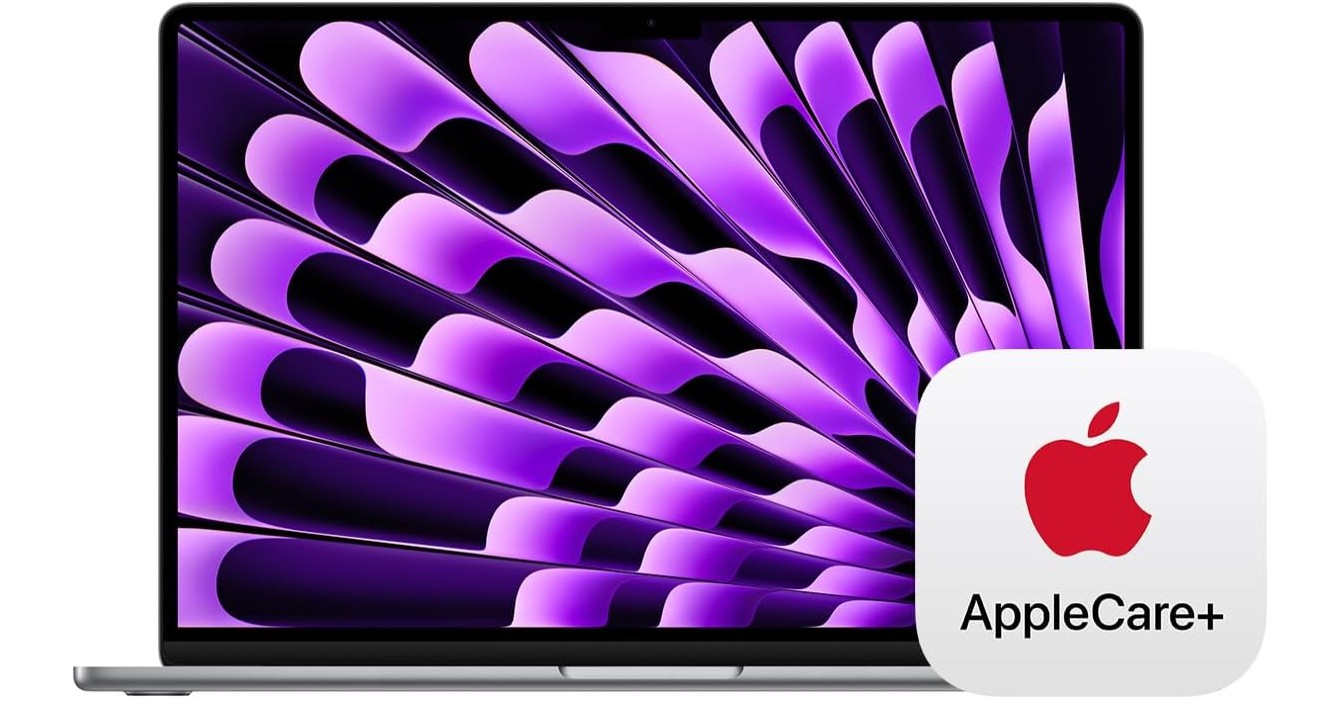
Apple 2024 MacBook Air 15-inch Laptop
Apple 2024 MacBook Air 15-inch Laptop
Design & Build Quality
The 2024 MacBook Air 15″ retains the Air’s signature thin-and-light form factor while stretching to a spacious 15.3-inch footprint. At just 1.13 cm thick and 1.51 kg, it’s remarkably portable for its size. Its unibody aluminum chassis in Space Gray feels sturdy and resists flex beneath the keyboard and palm rests. The MagSafe 3 charging port, coupled with two Thunderbolt 4/USB-C ports and a 3.5 mm headphone jack, maintains the Air’s hallmark simplicity without dongles. Overall, its minimalist aesthetic—blunt edges, tapered profile, and the illuminated Apple logo—grants a timeless elegance that fits both office and café settings.
Performance & Apple Intelligence
Powered by Apple’s M3 chip, the Air delivers a substantial performance upgrade over its M1 and M2 predecessors. The 8-core CPU (4 performance + 4 efficiency cores) and 10-core GPU handle everyday tasks—web browsing, video conferencing, and document editing—with ease and near-instantaneous responsiveness. Light creative workloads, such as photo editing in Lightroom or short-form video exports in iMovie, complete swiftly thanks to the unified architecture. The 16-core Neural Engine accelerates on-device machine-learning features—like Live Text recognition and Smart Summaries in Notes—making everyday interactions feel smarter and more intuitive.
Display Excellence
The 15.3″ Liquid Retina display is a standout feature. With a native resolution of 2880 × 1864, it strikes an ideal balance between sharpness and battery efficiency. Colors pop, thanks to full P3 wide-color gamut coverage, and images exhibit excellent contrast. True Tone automatically adjusts white balance to ambient lighting, reducing eye strain during extended sessions. Brightness peaks at around 500 nits, sufficient for indoor use and bright rooms, though glare can be noticeable outdoors under direct sunlight. The spacious canvas makes multitasking and side-by-side windows exceptionally comfortable.
Memory & Storage
Apple’s unified memory architecture unifies RAM and VRAM, enabling the 24 GB of unified memory to be dynamically shared between the CPU, GPU, and Neural Engine. This flexibility dramatically reduces bottlenecks when switching between apps or working with moderate-sized image and video files. The 512 GB SSD, while not the largest available, offers lightning-fast read/write speeds (up to 3,500 MB/s), ensuring near-instant application launches and file transfers. Users handling extensive RAW photo libraries or 4K video projects may need to rely on external drives, but general-purpose storage is snappy and plentiful.
Battery Life & Thermals
One of the Air’s hallmark strengths is battery endurance. With light to moderate usage—web browsing, document editing, streaming video—the MacBook Air 15″ easily reaches 15–18 hours of runtime. Even under heavier loads, such as continuous video playback or mixed productivity, it sustains a full workday without needing a charge. The fanless thermal design keeps operation silent but limits sustained turbo performance under prolonged CPU- and GPU-intensive workloads; occasional thermal throttling may occur during long export sessions.
Connectivity & Software Ecosystem
Connectivity remains simple yet effective: two Thunderbolt 4 ports facilitate external displays (up to one 6K display), high-speed storage, and charging, while MagSafe 3 preserves USB-C ports for data. Wi-Fi 6E and Bluetooth 5.3 deliver fast, reliable wireless performance. macOS Sequoia brings features like Stage Manager for window management, Continuity Camera for seamless wireless webcam use with an iPhone, and integrated Apple Intelligence enhancements. AppleCare+ extends warranty coverage to three years, offering peace of mind against accidental damage.
Verdict
The Apple 2024 MacBook Air 15″ with M3 strikes a rare balance of large, vibrant display; all-day battery life; and silent, solid performance in an incredibly thin-and-light chassis. It’s ideal for students, professionals, and creatives who prioritize portability, longevity, and macOS integration. While it isn’t designed as a sustained-powerworkstation under prolonged heavy loads, its everyday responsiveness, Apple Intelligence features, and three-year AppleCare+ warranty make it a compelling—and worry-free—choice in the 15″ ultraportable market.
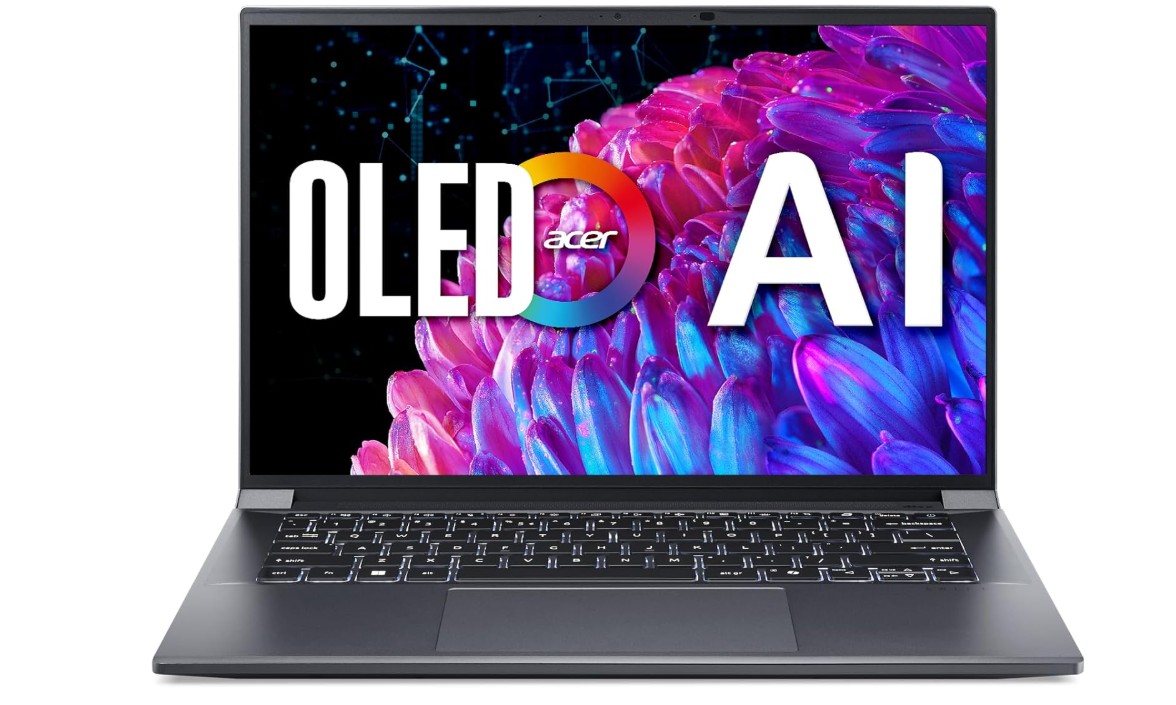
Acer Swift X 14 Laptop
Acer Swift X 14 Laptop
Design & Build Quality
The Acer Swift X 14 boasts a premium aluminum chassis that feels both sturdy and lightweight. Measuring just 15.9 mm thick and weighing approximately 1.40 kg, it excels as a truly portable machine. The matte gunmetal finish resists fingerprints, while the backlit chiclet keyboard and precision touchpad offer comfortable typing and navigation. Overall, the Swift X 14 strikes an excellent balance between sleek aesthetics and everyday durability.
Performance & CPU Power
At its core lies Intel’s Core Ultra 7 155H processor—a hybrid design featuring high-performance and efficiency cores. In benchmark testing, the CPU handles productivity tasks such as spreadsheet calculations, web browsing, and code compilation with ease. Multi-threaded workloads like batch image processing and light video transcoding complete noticeably faster than comparable 14-inch laptops. Thermal throttling is minimal under sustained load, thanks to Acer’s dual-fan cooling solution.
Graphics & AI Acceleration
The inclusion of the NVIDIA GeForce RTX 4060 Laptop GPU elevates the Swift X 14 beyond typical ultraportables. It delivers smooth 1080p gaming at medium to high settings—average frame rates hover around 60 fps in titles like Shadow of the Tomb Raider and Cyberpunk 2077 (DLSS Balanced). The GPU also accelerates AI-driven tasks; Acer’s “Unlock AI Experiences” utility leverages Tensor cores for on-device inference, boosting performance in creative apps that support NVIDIA AI SDKs.
Display Quality
Acer’s 14.5″ OLED panel is a standout feature. With a 2880 × 1800 resolution and 16:10 aspect ratio, it provides ample workspace for productivity and crisp detail for streaming or photo editing. The 120 Hz refresh rate ensures smooth scrolling and responsive interactions, while 100% DCI-P3 coverage and Calman verification promise accurate, vibrant colors. Contrast is virtually infinite, and peak brightness of around 400 nits makes indoor viewing a joy—though outdoor legibility under direct sunlight can be challenging.
Memory & Storage
With 16 GB of LPDDR5X RAM soldered onto the motherboard, multitasking feels snappy—switching between dozens of browser tabs, productivity suites, and light editing software occurs without hesitation. The 1 TB PCIe NVMe SSD delivers sequential read/write speeds in excess of 3,500 MB/s, resulting in near-instant boot times, rapid application launches, and swift file transfers. While the lack of upgradability for RAM is a constraint, the generous 1 TB SSD accommodates large media libraries and project files.
Connectivity & I/O
The Swift X 14’s port selection is thoughtful for its class. A Thunderbolt 4 (USB-C) port supports data, DisplayPort, and 65 W charging, while a USB 3.2 Gen 2 Type-A port adds legacy compatibility. An HDMI 2.1 output enables connection to external monitors at up to 4K 120 Hz, and a 3.5 mm audio jack covers headphones and microphones. Wi-Fi 6E and Bluetooth 5.3 deliver fast, low-latency wireless connectivity, ideal for online meetings and cloud-based workflows.
Battery Life & Thermals
Acer claims up to 10 hours of video playback on the 58 Wh battery, and real-world mixed-use tests yield around 7–8 hours of web browsing, document editing, and light streaming. Charging via the USB-C adapter replenishes 50% of capacity in approximately 30 minutes. The dual-fan cooling system keeps surface temperatures comfortable—keyboard deck stays under 40 °C and fan noise peaks around 42 dB under load, making it discreet in office or library settings.
Verdict
The Acer Swift X 14 (SFX14-72G-77NJ) distinguishes itself as a versatile ultraportable that bridges productivity, creative work, and casual gaming. Its combination of Intel’s hybrid-core CPU, RTX 4060 GPU, and high-quality 14.5″ OLED display offers a compelling value proposition. While soldered RAM limits future upgrades, the generous storage, strong battery life, and robust connectivity make it an excellent choice for professionals and students seeking a lightweight yet powerful machine.
Buying Guide: High-End Laptops for Gaming and Video Editing
In today’s performance-hungry landscape, a high-end laptop that can handle both intensive gaming and professional video editing is no longer a luxury—it’s a necessity for power users, creators, and competitive gamers. But finding a machine that balances both GPU power and software optimization can be challenging. This guide breaks down all the key components, features, and specs to look for in a high-performance laptop for dual-purpose use.
1. CPU (Processor): The Core of Productivity and Rendering
For video editors and gamers alike, the CPU is the brain of the laptop. High-end video editing apps like Adobe Premiere Pro, DaVinci Resolve, and After Effects rely on strong multi-core performance for rendering and encoding.
Top CPU Choices (2025):
- Intel Core i9-14900HX – A 24-core powerhouse ideal for multitasking and 4K+ video editing.
- Apple M4 Pro or M4 Max (MacBooks) – Unmatched efficiency and software optimization for Final Cut Pro and Apple-native workflows.
- AMD Ryzen 9 7945HX – A strong contender with great multi-threading performance, especially in Blender and Resolve.
Tip: Look for H-series or HX-series chips in Windows laptops for maximum power.
2. GPU (Graphics Card): Gaming Power + Video Acceleration
A powerful dedicated GPU is critical for both modern gaming at high resolutions and GPU-accelerated tasks in editing software (like rendering, motion graphics, and effects previews).
Recommended GPUs for High-End Laptops:
- NVIDIA RTX 4090 / 4080 Laptop GPU – Desktop-level performance with full support for ray tracing, DLSS 3.5, and CUDA acceleration.
- Apple M4 Max – Includes a 40-core GPU (on higher-end configurations), well-optimized for Final Cut Pro and Apple Intelligence features.
- RTX 4070 or 4060 – Still strong enough for QHD gaming and mid-level 4K editing tasks at lower price points.
Pro Tip: Choose a laptop with Studio Drivers (NVIDIA Studio laptops) if your focus is more on content creation than gaming.
3. Display: Color Accuracy Meets High Refresh Rates
High-end laptops should deliver both color precision and fluid visuals. Gamers benefit from higher refresh rates, while editors require accurate colors and higher resolutions.
Display Features to Prioritize:
- Resolution: Minimum QHD+ (2560×1600), ideally 4K UHD or 3.2K (especially for editing).
- Color Gamut: 100% DCI-P3 or AdobeRGB for accurate color grading.
- Display Type: OLED or mini-LED panels offer better contrast and HDR support.
- Refresh Rate: 120Hz or higher for smooth gaming performance (240Hz is ideal for eSports).
Best Options:
- 16” or 18” QHD+ 240Hz Mini-LED Panels (e.g., ASUS ROG Nebula Display)
- Apple’s Liquid Retina XDR (16.2”)
- OLED Panels in Acer Swift X or Dell XPS models
4. RAM (Memory): For Multitasking and Large Projects
Modern workflows demand lots of RAM, especially when running editing software alongside plugins, asset libraries, and background apps.
Recommended RAM for High-End Use:
- Minimum: 32 GB DDR5
- Ideal: 64 GB DDR5 or LPDDR5X
If you’re using After Effects, DaVinci Resolve, or working with 4K–8K timelines, 64 GB ensures long-term headroom. Apple’s unified memory (24 GB or 36 GB) is efficient, but only upgradeable at purchase.
Note: Make sure it’s dual-channel for better performance.
5. Storage: Speed & Capacity for Massive Projects
Video files, game installs, and project assets take up huge space. You’ll want a fast and spacious SSD to ensure your system boots fast and files open instantly.
Ideal Specs:
- Type: NVMe PCIe Gen 4 SSD
- Capacity: Minimum 1 TB; Ideal 2–8 TB for creators
- Read/Write Speeds: 3000+ MB/s for faster export times
Some laptops offer dual SSD slots, allowing RAID 0 for even faster speeds or RAID 1 for data redundancy.
6. Thermal Design & Cooling
High performance generates heat, especially when both CPU and GPU are under full load. A premium laptop must have an advanced cooling system to prevent thermal throttling and maintain sustained performance.
Look For:
- Vapor chamber cooling
- Dedicated intake/exhaust vents
- Software-controlled fan modes (silent, turbo, performance)
Brands like Alienware, ASUS ROG, and MSI Raider offer some of the best thermal designs with adjustable performance profiles.
7. Battery Life: Secondary but Still Relevant
Gaming and editing will mostly be done while plugged in, but if portability matters, battery life can’t be ignored.
Battery Guidelines:
- Editing/Light Use: Expect 6–10 hours on premium models like the MacBook Pro M4.
- Gaming: Typically 2–4 hours max on battery, with power-limited performance.
Apple still leads in battery efficiency, while Intel Core Ultra laptops with Intel Evo certification offer balanced performance and battery life.
8. Build Quality & Portability
Most high-end laptops are 15.6″ to 18″, which can be heavy. But creators on the go might prioritize lightweight builds with premium materials.
Prioritize:
- Magnesium/aluminum chassis
- Thin bezels for a compact footprint
- Military-grade durability ratings (MIL-STD 810H)
If you want something powerful yet light, Apple’s 16” MacBook Pro M4 Max or ASUS ROG Zephyrus G14 are ideal.
9. Ports & Connectivity
External drives, displays, and cameras are essential for creators, so connectivity matters more than ever.
Must-Have Ports:
- Thunderbolt 4 / USB 4 (Type-C)
- HDMI 2.1 for external 4K displays
- SD Card Reader (UHS-II)
- Ethernet (for streaming or LAN gaming)
- Wi-Fi 6E or Wi-Fi 7
Bluetooth 5.3 or newer ensures low-latency audio, essential for editing on wireless headphones.
10. Operating System: Windows vs macOS
Your workflow may determine the OS you choose.
- Windows 11 Pro is compatible with nearly all gaming titles and Adobe, Blackmagic, and Autodesk software.
- macOS (M4 Pro/Max) is optimized for Apple’s own tools (Final Cut, Logic Pro) and offers tight hardware-software integration.
Note: Gaming on macOS is improving thanks to Game Porting Toolkit and M4 GPU performance, but Windows remains dominant in game support.
Final Thoughts: Balance Is Key
When investing in a high-end laptop for both gaming and video editing, balance is critical. You want:
- A powerful CPU and GPU combo,
- A high-res, color-accurate display,
- Fast RAM and storage,
- A strong cooling system, and
- A build that suits your workflow—whether that’s portability or desktop replacement.
Make sure the machine you choose not only handles today’s workloads but is future-proofed for the next 3–5 years of gaming engines and editing software.
A passionate tech enthusiast with a deep interest in the latest innovations, gadgets, and emerging technologies. Always eager to explore cutting-edge hardware and software, I enjoy sharing insights, reviews, and recommendations to help others make informed decisions in the ever-evolving tech world. With a curious mindset and hands-on approach, I stay up-to-date with industry trends, from PCs and gaming to mobile devices and AI-driven tools.






